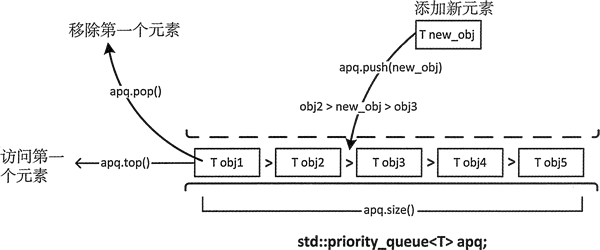C++ priority_queue 图片看不了?点击切换HTTP 返回上层
不出所料,priority_queue 容器适配器定义了一个元素有序排列的队列。默认队列头部的元素优先级最高。因为它是一个队列,所以只能访问第一个元素,这也意味着优先级最高的元素总是第一个被处理。但是如何定义“优先级”完全取决于我们自己。如果一个优先级队列记录的是医院里等待接受急救的病人,那么病人病情的严重性就是优先级。如果队列元素是银行的借贷业务,那么借记可能会优先于信贷。
priority_queue 模板有 3 个参数,其中两个有默认的参数;第一个参数是存储对象的类型,第二个参数是存储元素的底层容器,第三个参数是函数对象,它定义了一个用来决定元素顺序的断言。因此模板类型是:
如你所见,priority_queue 实例默认有一个 vector 容器。函数对象类型 less<T> 是一个默认的排序断言,定义在头文件 function 中,决定了容器中最大的元素会排在队列前面。fonction 中定义了 greater<T>,用来作为模板的最后一个参数对元素排序,最小元素会排在队列前面。当然,如果指定模板的最巵一个参数,就必须提供另外的两个模板类型参数。

图 1
图 1 中显示元素的方式反映了它们被检索的顺序。在 vector 中它们也可以不像这样排序。在讨论堆时,会解释原因。
可以用适当类型的对象初始化一个优先级队列:
初始化列表中的序列可以来自于任何容器,并且不需要有序。优先级队列会对它们进行排序。
拷贝构造函数会生成一个和现有对象同类型的 priority_queue 对象,它是现有对象的一个副本。例如:
也有带右值引用参数的拷贝构造函数,它可以移动一个实参对象。
当对容器内容反向排序时,最小的元素会排在队列前面,这时候需要指定 3 个模板类型参数:
这会通过使用 operator>() 函数对字符串对象进行比较,进而生成一个优先级队列,因此这会和它们在队列中的顺序相反。
优先级队列可以使用任何容器来保存元素,只要容器有成员函数 front()、push_back()、pop_back()、size()、empty()。这显然包含了 deque 容器,因此这里也可以用 deque 来代替:
这个 words 优先级队列在 deque 容器中保存了一些 wrds 数组中的字符串,这里使用默认的比较断言,因此队列中的元素会和上面 word1 中元素的顺序相同。priority_queue 构造函数会生成一个和第二个类型参数同类型的容器来保存元素,这也是 priority_queue 对象的底层容器。
可以生成 vector 或 deque 容器,然后用它们来初始化 priority_queue。下面展示了如何以 vector 的元素作为初始值来生成 priority_queue 对象:
priority_queue 构造函数的第一个参数是一个用来对元素排序的函数对象,第二个参数是一个提供初始元素的容器。在队列中用函数对象对 vector 元素的副本排序。values 中元素的顺序没有变,但是优先级队列中的元素顺序变为:56 54 24 22 21 12 3。优先级队列中用来保存元素的容器是私有的,因此只能通过调用 priority_queue 对象的成员函数来对容器进行操作。构造函数的第一个参数是函数对象类型,它必须和指定的比较模板类型参数相同,函数对象类型默认是 less<T>。如果想使用不同类型的函数,需要指定全部的模板类型参数。例如:
第三个类型参数是一个比较对象类型。如果要指定这个参数,必须指定前两个参数——元素类型和底层容器类型。
priority_queue 也实现了赋值运算,可以将右操作数的元素赋给左操作数;同时也定义了拷贝和移动版的赋值运算符。需要注意的是,priority_queue 容器并没有定义比较运算符。因为需要保持元素的顺序,所以添加元素通常会很慢。稍后会在堆(heaps)一节讨论 priority_queue 的内部操作。
以下展示了如何将键盘输入的数据记录到 priority_queue 中:
按下 Ctrl+Z 组合键会在输入流中设置文件结束状态,因此可以用来结束循环输入。istream 对象的成员函数 operator>>() 返回一个输入流对象,因此我们可以用 if 条件表达式来调用 eof() 以检查 cin 的状态。这里会对输入单词进行排序,所以最大的单词总在 words 队列的前面——自动对输入单词排序。
priority_queue 没有迭代器。如果想要访问全部的元素,比如说,列出或复制它们,会将队列清空;priority_queue 和 queue 有相同的限制。如果想在进行这样的操作后,还能保存它的元素,需要先把它复制一份,这里可以使用一个不同类型的容器。下面展示了如何列出优先级队列 words 的内容:
这里首先生成了一个 words 的副本,因为输出 words 会移除它的内容。输出 top() 返回的元素后,我们需要使用 pop() 来使下一个元素可访问。移除全部元素后,在循环条件中调用 empty() 以结束循环。也可以使用表达式 words_copy.size() 来控制循环,因为返回值会被隐式转换为布尔值,这样在 size() 返回 0 时,表达式的结果为 false。
如果为 words 输入:
参数是以传值方式传入的,因此这里会处理一个优先级队列的副本。它是一个适用于任何类型容器的函数模板,只要容器实现了用于向 ostream 输出的 operator<<() 函数。如果没有设置第二个参数,默认每 5 个输出值一行。当然也可以定义一个适用于 queue 容器适配对象的函数模板。可以如下所示使用 priority_queue 的成员函数 emplace():
以字符串为参数调用 string 类的构造函数会在容器的适当位置生成一个对象。这比下面的语句更有效率:
这里编译器会在字符文字处插入一个 string 构造函数来生成 push() 的参数,然后以这个临时 string 对象作为参数调用 push()。push() 函数然后会调用 string 类的拷贝构造函数来将生成对象添加到容器中。我们把这些代码段组织成一个完整的程序:
运行结果为:
priority_queue 模板有 3 个参数,其中两个有默认的参数;第一个参数是存储对象的类型,第二个参数是存储元素的底层容器,第三个参数是函数对象,它定义了一个用来决定元素顺序的断言。因此模板类型是:
1 | template <typename T, typename Container=std::vector<T>, typename Compare=std::less<T>> class priority_queue |

图 1
图 1 中显示元素的方式反映了它们被检索的顺序。在 vector 中它们也可以不像这样排序。在讨论堆时,会解释原因。
创建 priority_queue
可以如下所示生成一个空的优先级队列:1 | std::priority_queue<std::string> words; |
1 2 | std::string wrds[] { "one", "two", "three", "four"};std::priority_queue<std::string> words { std::begin(wrds),std:: end(wrds)}; // "two" "three" "one" "four" |
拷贝构造函数会生成一个和现有对象同类型的 priority_queue 对象,它是现有对象的一个副本。例如:
1 | std::priority_queue<std::string> copy_words {words}; // copy of words |
当对容器内容反向排序时,最小的元素会排在队列前面,这时候需要指定 3 个模板类型参数:
1 2 | std:: string wrds[] {"one", "two", "three", "four"};std::priority_queue<std::string, std::vector<std::string>,std: :greater<std::string>> words1 {std::begin (wrds) , std:: end (wrds) }; //"four" "one" "three" "two" |
优先级队列可以使用任何容器来保存元素,只要容器有成员函数 front()、push_back()、pop_back()、size()、empty()。这显然包含了 deque 容器,因此这里也可以用 deque 来代替:
1 2 | std::string wrds [] {"one", "two", "three", "four"};std::priority_queue<std::string, std::deque<std::string>> words {std::begin(wrds), std::end(wrds)}; |
可以生成 vector 或 deque 容器,然后用它们来初始化 priority_queue。下面展示了如何以 vector 的元素作为初始值来生成 priority_queue 对象:
1 2 | std::vector<int> values{21, 22, 12, 3, 24, 54, 56};std::priority_queue<int> numbers {std::less<int>(),values}; |
1 | std::priority_queue<int, std::vector<int>,std::greater<int>> numbersl {std::greater<int>(), values}; |
priority_queue 操作
对 priority_queue 进行操作有一些限制:- push(const T& obj):将obj的副本放到容器的适当位置,这通常会包含一个排序操作。
- push(T&& obj):将obj放到容器的适当位置,这通常会包含一个排序操作。
- emplace(T constructor a rgs...):通过调用传入参数的构造函数,在序列的适当位置构造一个T对象。为了维持优先顺序,通常需要一个排序操作。
- top():返回优先级队列中第一个元素的引用。
- pop():移除第一个元素。
- size():返回队列中元素的个数。
- empty():如果队列为空的话,返回true。
- swap(priority_queue<T>& other):和参数的元素进行交换,所包含对象的类型必须相同。
priority_queue 也实现了赋值运算,可以将右操作数的元素赋给左操作数;同时也定义了拷贝和移动版的赋值运算符。需要注意的是,priority_queue 容器并没有定义比较运算符。因为需要保持元素的顺序,所以添加元素通常会很慢。稍后会在堆(heaps)一节讨论 priority_queue 的内部操作。
以下展示了如何将键盘输入的数据记录到 priority_queue 中:
1 2 3 4 5 6 7 8 | std::priority_queue<std::string> words;std::string word; std::cout << "Enter words separated by spaces, enter Ctrl+Z on a separate line to end:\n";while (true){ if ((std::cin >> word).eof()) break; words.push(word);} |
priority_queue 没有迭代器。如果想要访问全部的元素,比如说,列出或复制它们,会将队列清空;priority_queue 和 queue 有相同的限制。如果想在进行这样的操作后,还能保存它的元素,需要先把它复制一份,这里可以使用一个不同类型的容器。下面展示了如何列出优先级队列 words 的内容:
1 2 3 4 5 6 7 | std::priority_queue<std::string> words_copy {words}; // A copy for outputwhile (!words_copy.empty()){ std:: cout << words_copy.top () <<" "; words_copy.pop();}std::cout << std::endl; |
如果为 words 输入:
one two three four five six seven
^Z
two three six seven one four five
当然,如果需要多次输出 priority_queue 的内容,最好定义一个函数。这个函数应该是通用的,如下所示:1 2 3 4 5 6 7 8 9 10 11 12 13 14 15 | template<typename T>void list_pq(std::priority_queue<T> pq, size_t count = 5){ size_t n{count}; while (!pq. empty()) { std::cout << pq. top() << " "; pq.pop(); if (--n) continue; std::cout << std::endl; n = count; } std::cout << std::endl;} |
1 | words.emplace("nine"); |
1 | words.push("nine"); |
1 2 3 4 5 6 7 8 9 10 11 12 13 14 15 16 17 18 19 20 21 22 23 24 25 26 27 28 29 30 31 32 33 34 35 36 | // Exercising a priority queue container adapter#include <iostream> // For standard streams#include <queue> // For priority_queue<T>#include <string> // For string classusing std::string;// List contents of a priority queuetemplate<typename T>void list_pq(std::priority_queue<T> pq, size_t count = 5){ size_t n {count}; while (!pq.empty()) { std::cout << pq.top() << " "; pq.pop(); if (--n) continue; std::cout << std::endl; n = count; } std::cout << std::endl;}int main(){ std::priority_queue<std::string> words; std::string word; std::cout << "Enter words separated by spaces, enter Ctrl+Z on a separate line to end:\n"; while (true) { if ((std::cin >> word).eof()) break; words.push(word); } std::cout << "You entered " << words.size() << " words:" << std::endl; list_pq(words);} |
Enter words separated by spaces, enter Ctrl+Z on a separate line to end:
one two three four five six seven eight nine ten eleven twelve
^Z
You entered 12 words:
two twelve three ten six
seven one nine four five
eleven eight
